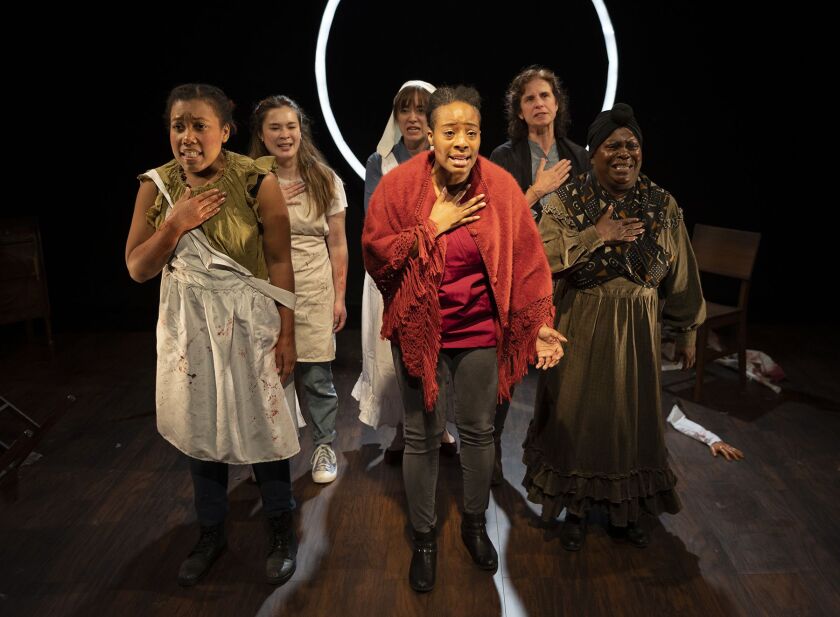Mary Seacole lived a remarkable, barrier-shattering life inherently dramatic enough to be ripe for stage treatment. Born in 1805 Jamaica under British colonial rule, she eventually travelled the world throughout the 19th century, a single black woman applying her abilities as a nurse/doctor/healer as she went. She also opened several hotels, wrote an autobiography and counted English royals among her patrons before she died in 1881.
With “Marys Seacole,” playwright Jackie Sibblies Drury (who won a Pulitzer Prize in 2019 for her comedy “Fairview”) attempts to capture the radical, epic life of a woman who spent the bulk of her years tending to the medical needs of people in crisis, whether on the front lines of the Crimean War or the epicenter of a South American cholera outbreak. As the title indicates, we see multiple Marys in Griffin Theatre’s 90-minute production, directed at rapid-fire pace by Jerrell L. Henderson and Hannah Todd.
But Drury’s non-linear, time-traveling fever-dream of a script sometimes gets in its own way, making the phenomenal woman at the center of its prismatic swirls difficult to see.
Drury shows us Mary not just in her London hotel or the Crimean war front of the 1850s but in a present-day playground, watching children, caring for a demanding old woman in a hospital room filled with 21st-century beeps and buzzes, and tending to hotel guests at an establishment in 19th-century Jamaica.
With minimal, sometimes disorienting transitions, Henderson and Todd make Drury’s emphasis crystalline: No matter the century or the circumstance, woman-as-caregiver is a role as old as time itself. Mary Seacole played it with historic impact.
The bullet points of her life come through in furious increments. Although Seacole had years of experience tending to cholera victims in South America and maladies of all sorts in the Caribbean, both Florence Nightingale and the British War Office rebuffed Seacole’s ardent efforts to volunteer during the Crimean War in the 1850s. She went anyway. (Salman Rushdie scathingly references this in “The Satanic Verses”: “See, here is Mary Seacole, who did as much in the Crimea as another magic-lamping lady, but, being dark, could scarce be seen for the flame of Florence’s candle.”)
When the lights come up on Stephanie Mattos’ take on Mary, it’s a moment of sudden majesty. For a fraught, intentional pause she’s simply silent, standing regally in a spotlight as if assessing whether to continue with the proceedings. She does, of course, in an exhausting, shapeshifting depiction. Mattos keeps Mary grounded with a core of grit, light and heart as she skips through time and over continents.
Mary’s journey is the center of “Marys Seacole,” but the shamanic Duppy Mary (RjW Mays) seems to be overseeing the arc of the story. Duppy Mary is silent for much of the play, but the force of her power is never in doubt. And when she does use words, it’s with unadulterated ferocity.
Her power is hinted at in Anna Wooden’s costume design, which has Duppy Mary all in dun-and-dirt colors, except for an apron top that’s covered in an orange and black pattern that hits the eye like some kind of symbol. (Wooden does great work throughout, including putting Mattos in a subtly eye-popping replication of an mid-1800s gown at lights up.)
A swirl of other women characters — all with “M” names — surround the Marys through space and time: Izzie Jones (Miriam) is tragically hilarious as a tot lot mom who, upon learning Mary is from Jamaica, rattles on about how much she loves the food/culture there, based on her honeymoon. Jesi Mullins (May) makes Florence Nightingale frostier and smugger than Miranda Priestly. Throughout, the ensemble (which also includes Mackenzie Williams and India Whiteside as Mamie and Merry, respectively) remains agile.
“Marys Seacole” offers a fascinating glimpse into the life of Mary Seacole. But it’s only a glimpse, surrounded by kaleidoscopic context.






